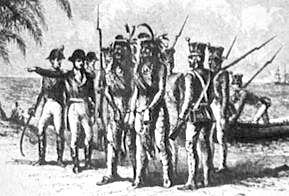The Seminole Wars
After the American Revolution (1776-1783), Spain regained control of Florida from Britain as part of the Treaty of Paris. When the British evacuated Florida, Spanish colonists as well as settlers from the newly formed United States came pouring in. Many of these new residents were lured by favorable Spanish terms for acquiring property, called land grants. Even Seminoles were encouraged to set up farms, because they provided a buffer between Spanish Florida and the United States. Escaped slaves also entered Florida, trying to reach a place where their U.S. masters had no authority over them.
Instead of becoming more Spanish, Florida increasingly became more "American."
The First Seminole War
Back when Britain controlled Florida, the British often incited Seminoles against American settlers who were migrating south into Seminole territory. These old conflicts, combined with the safe-haven Seminoles provided black slaves, caused the U.S. army to attack the tribe in the First Seminole War (1817-1818), which took place in Florida and southern Georgia. Forces under Gen. Andrew Jackson invaded Spanish Florida, attacked several key locations, and pushed the Seminoles farther south into Florida.

St. Marks, Fla., April 1818 -- Two Seminole chiefs, or micos are captured by Jackson's forces who used the ruse of flying the British flag to lure the Indians to them.
Image from the Florida State Archives.
Finally, after several official and unofficial U.S. military expeditions into the territory, Spain formally ceded Florida to the United States in 1821, according to terms of the Adams-Onís Treaty.
As soon as the United States acquired Florida, it began urging the Indians there to leave their lands and relocate along with other southeastern tribes to Indian Territory, present-day Oklahoma. Some Seminole leaders signed a treaty in 1832, and part of the tribe moved. But other Seminoles refused to recognize the treaty and fled into the Florida Everglades.
The Second Seminole War
The Treaty of Payne's Landing, signed by a small number of Seminoles in May 1832, required Indians to give up their Florida lands within three years and move west. When the U.S. Army arrived in 1835 to enforce the treaty, the Indians were ready for war.
As Major Francis Dade marched from Fort Brooke toward Fort King, 180 Seminole warriors led by Micanopy, Alligator and Jumper attacked. Only one man of that army detachment survived the ambush.
The campaigns of the Second Seminole War were an outstanding demonstration of guerrilla warfare by the Seminole. TheMicos Jumper, Alligator, Micanopy and Osceola, leading less than 3,000 warriors, were pitted against four U.S. generals and more than 30,000 troops.
The Second Seminole War (1835-1842), usually referred to as the Seminole War proper, was the fiercest war waged by the U.S. government against American Indians. The United States spent more than $20 million fighting the Seminoles. The war left more than 1,500 soldiers and uncounted American civilians dead. And the obvious duplicity of the U.S. government's tactics marred Indian-white relations throughout the country for future generations.
As the hostilities dragged on, frustrated U.S. forces increasingly turned to desperate measures to win the war. For example, Osceola was captured and imprisoned when he met with U.S. troops who had called for a truce and claimed to want to talk peace.
With Osceola in prison, the United States was confident the war would end soon. But it did not. Although Osceola died in prison in 1838, other Seminole leaders kept the battle going for a few more years.
In 1842, a nominal end to the hostilities arrived, though no peace treaty was ever signed. By this time most Seminoles had been moved from Florida, relocated to Indian Territory today's Oklahoma.
The Third Seminole War
A Third Seminole War broke out in 1855, when conflicts -- largely over land -- arose between whites and some Seminoles who remained in Florida. Constant military patrols and rewards for the capture of Indians reduced the Seminole population to about 200 when the Third Seminole War ended in 1858.
